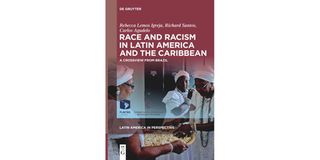The racial discrimination of black women in Latin America

What you need to know:
- The pervasive cultural practice of "Mejorando la Raza" represents a systematic dehumanisation of Black women across 20 Spanish-speaking Latin American nations.
- This discriminatory mentality stems from the brutal colonial legacy of the Trans-Atlantic slave trade that trafficked 10 million enslaved Africans to Latin America, creating sophisticated caste systems that relegated Black women to the bottom of social hierarchies.
In 2010, American Lavender Brown, an attractive Black New Orleans, Louisiana descendant, was a sophomore University of Guadalajara Spanish student when she accepted an invitation from her Mexican boyfriend to meet his mother. During the formality, Lavender encountered a glaringly torrid and antagonising reception from her boyfriend's mother, who was vividly appalled by her existential Black appearance.
She retreated to the restroom where she sobbed uncontrollably while nursing her disorientation. In her subsequent extensive stay in Guadalajara, she incurred the commonality of that imperious discrimination in her prevailing relationships.
A derogatory Latin phrase, Mehula Larasa, is ubiquitous with all Spanish speaking Latin American nations and directly translates to 'improving the race.' The definitive description of 'improving the race' is 'whitening' it by cohabiting and conceiving children with lighter-skinned individuals, preferably Caucasians and pale skinned-toned Hispanics. The demeaning cultural practice is overtly exerted in all 20 Spanish speaking North American, Caribbean and South American nations to reinforce what residents define as 'non-contamination' of Latinas.
When Lavender's boyfriend introduced his Black girlfriend to her mother, she interpreted it as an affront to Mehula Larasa. A Black woman to her degraded their race and discarded her ambition of 'whitening' her family to exalt future generations.
In her eyes, he disrespected her and the Hispanic custom due to the cultural affirmation that the race is to be faded to improve it. If her son would have introduced her to a white woman, she would have brazenly embraced the idea with exhilaration, regardless of whether she was unattractive or unintelligent.
Blonde hair
Mehula Larasa is a cultural instrument expedited to implement Eurocentric features that genetically coronate the next generation of Hispanic families with blue or brown eyes and blonde hair. Every Spanish speaking Latin American nation perceives Black women as a prohibition to the accomplishment of this attainment and subscribes to the prejudiced ignorance and dehumanising discrimination of Black women.
Between 1501 and 1867 during the Trans-Atlantic slave trade, an estimated 12 million enslaved Africans were trafficked to the United States. Ten million were trafficked to Latin American nations of El Salvador, Dominican Republic, Cuba, Mexico, Puerto Rico, Costa Rica, Nicaragua, Panama, Ecuador, Colombia, Argentina, Paraguay, Peru, Venezuela, Bolivia, Uruguay, Chile and Portuguese dominated Brazil.
During the treacherous journey from the coastal regions of West Africa, over 12,000 slave ships were used and there were an excess of two million deaths of Black people. Between 1580 and 1640, Brazil alone is estimated to have received five million slaves. Slave trafficking during colonisation and the extended period in which slavery was legal, left an atrocious mark on the Latin American social structure and psychological perception.
Race and Racism in South America and the Caribbean: A Crossview from Brazil, is an eloquently written educational manualthatenlightens, illustrates and elaborates how the Latin American population was indoctrinated and conditioned to undervalue Black women. Racial discrimination's perverse existence was reinforced by the political, social and cultural evolution of each society and that mentality currently reverberates exhaustively in Latin America.

In Portuguese speaking Brazil, the most traumatic and preliminary form of abuse was constituted by the rape of Black women by colonisers. Black women were perceived as objects of white male gratification and the biracial offspring of the rape travesty were known by the derogatory term, mestizos. They were grossly subjugated and subjected to oppressive treatment.
Children of Black women who later engaged in miscegenation, which is cross racial interaction and child conception, were referred to by different vilifying terms including mestizas and mulattoes. A casté system was developed to rank white Portuguese Europeans higher in the social pyramid, descended by mulattoes andensued by Blacks who dominated the bottom of the casté system. These racial dispostifs perpetrated racially prejudiced and sexually discriminatory laws that excluded Black women from the benefits of development.
The autocracy of segregation was widespread throughout Latin America with a sophisticated casté system that generated derogatory classifications such as mulato, pardo, moreno, zambo, ladino and cholo. Thesedemeaning racial segmentations, strategically placed biracial and Black women at the bottom of the social hierarchy and persistently led to the discrimination of Black women by all races.
Also read: Reflecting on African identity
Neighbouring Argentina, Chile and Uruguay aren't bequeathed by the superiority complex of white colonisation and have some of the worst social structures of racial discrimination. Black women in these nations have historically been relegated into a subservient solitude of isolation. By the end of the nineteenth century, the dream of Argentine President Domingo Faustino Sarmiento, which involved whitening the country, was achieved.
Sarmiento ruled Argentina from 1868 to 1874 and played a prolific role in exterminating the Afro-Argentine population, labelling Argentina an all-white extension of Western Europe. Under his racist regime, he created a white power structure and systematically erased Blacks from Argentina. Blacks and whites were segregated, and Black women were reduced to diminutive discriminatory roles of washing clothes, domestic service occupations and callejeras (street vendors).
Sarmiento comprehensively extended his nefarious policies of eliminating Black people from societal presence by advocating for white European racial purity. He implemented atrocious laws that consolidated the imprisonment of Blacks through minor and fabricated charges while orchestrating mass genocidal executions. Black women and children who survived the genocide were coerced to flee to neighbouring nations.
Jeff Anthony is a novelist, Big Brother Africa 2 Kenyan representative and founder of Jeff's Fitness Centre @jeffbigbrother


